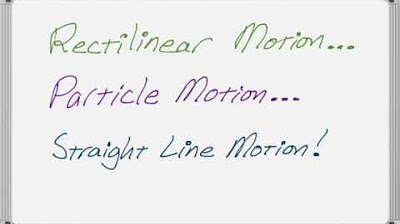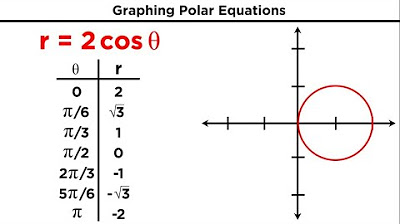AP Physics 2023 Exam Solutions|Q2. PART A ( ii) | Complete Step-by-Step Answers and Explanations"
TLDRThe second part of the question involves plotting a graph to determine the acceleration of a cart coming down an incline. By labeling the axes and plotting the points, a straight line passing through the origin is obtained, where the x-axis represents t²/2 and the y-axis represents the position. The slope of the line, calculated using two points, gives the experimental acceleration of the cart as 1.22 m/s². This value is derived from the data plotted on the graph.
Takeaways
- 📈 The task involves the second part of a physics problem concerning the acceleration of a cart moving down an incline.
- 📚 The first part of the question has already been completed, and this script addresses the second part, focusing on graph plotting.
- 📏 The positive x-direction is chosen along the incline, with the cart's movement considered positive in the x-direction.
- 📊 The script instructs to plot the graph with 'x' as the independent variable and the position 'X' as the dependent variable.
- 📉 The equation of motion given is X = (1/2)at², which simplifies to X = at²/2 for plotting purposes.
- 📍 The script describes the process of plotting points based on the provided data and drawing a straight line that passes through the origin.
- 📌 The slope of the straight line graph represents the acceleration 'a' of the cart.
- 🔍 The script details the method of finding the slope by selecting two points on the line and calculating the change in y divided by the change in x.
- 📝 The experimental value of acceleration 'a' is calculated to be 1.22 m/s² by using the slope of the graph.
- 🔢 The process involves mathematical operations such as subtraction and division to find the slope and, consequently, the acceleration.
- 🎓 The script concludes by summarizing the method used to determine the acceleration of the block rolling down the incline using a graphical approach.
Q & A
What is the second part of question 2 in the transcript about?
-The second part of question 2 is about plotting the appropriate quantities on a graph to determine the acceleration 'a' of a cart coming down an incline.
What was the chosen positive X direction in the experiment?
-The positive X direction was chosen to be along the incline, in the direction the cart was moving.
What mathematical equation is being plotted on the graph?
-The equation being plotted is X = (1/2)at², where X is the position along the incline and t is time.
What are the independent and dependent variables in the graph?
-The independent variable is time squared (t²), and the dependent variable is the position X along the incline.
How is the acceleration 'a' represented on the graph?
-The acceleration 'a' is represented as the slope of the straight line graph that passes through the origin.
What is the significance of the straight line passing through the origin in the graph?
-The straight line passing through the origin indicates that the initial velocity of the cart is zero, and the motion is uniformly accelerated from rest.
How many points are used to plot the graph in the transcript?
-Four points are used to plot the graph, corresponding to different time intervals and positions of the cart.
What is the method to calculate the experimental value of acceleration 'a'?
-The experimental value of acceleration 'a' is calculated by finding the slope of the straight line graph, which is the change in position divided by the change in time squared.
What are the two points chosen to calculate the slope of the line in the transcript?
-The two points chosen are (0.24, 0.174) and (0.14, 0.296), which correspond to different values of time squared and position.
What is the calculated acceleration of the block as it rolls down the incline?
-The calculated acceleration of the block is 1.22 m/s², obtained by finding the slope of the graph.
How does the transcript ensure the graph accurately represents the experimental data?
-The transcript ensures accuracy by plotting the data points, connecting them with a straight line, and then calculating the slope of this line to find the acceleration.
Outlines
📈 Graphing Acceleration Data
The script describes the process of plotting data to determine the acceleration 'a' of a cart moving down an incline. The cart's position along the incline is represented on the y-axis against time squared divided by two on the x-axis. The graph is expected to be a straight line passing through the origin, with the slope representing the acceleration. Key points from the data are identified and plotted, resulting in a linear graph that visually represents the motion of the cart.
🧭 Calculating Acceleration from the Graph
The second part of the script focuses on calculating the experimental value of acceleration 'a' using the graph plotted in the first part. The slope of the line is determined by selecting two points on the graph and calculating the change in y over the change in x. The specific points chosen are (0.24, 0.174) and (0.296, 0.14), and the slope calculation simplifies to 1.22. This value is interpreted as the acceleration of the block as it rolls down the incline, expressed in meters per second squared (m/s²).
Mindmap
Keywords
💡acceleration
💡incline
💡graph
💡slope
💡position
💡t²/2
💡data points
💡experimental value
💡straight line
💡origin
Highlights
Introduction of the second part of question 2, a continuation from the first part.
Description of the cart's motion down an incline and the positive X direction chosen for analysis.
Explanation of the graph's axes labeling and scaling for plotting data.
The mathematical relationship X = 1/2 * at² is established for plotting.
Identification of the independent variable (time squared) and the dependent variable (position).
The slope of the graph represents the acceleration 'a' of the cart.
Plotting of points based on the given data to create a straight line graph.
The graph is expected to be a straight line passing through the origin, indicating a direct relationship.
Marking specific points from the data to be plotted on the graph.
Connecting the dots to visualize the straight line representing the cart's acceleration.
Calculation of the experimental value of acceleration 'a' using the slope of the plotted line.
Selection of two points on the graph to calculate the slope and thus the acceleration.
Mathematical computation to find the slope and acceleration, resulting in a value of 1.22 m/s².
Conclusion of the second part of the question with the experimental value of acceleration.
Acknowledgment of the completion of part two and transition to the third part of the question.
The practical application of the graph in determining the acceleration of an object in motion.
The importance of accurate data plotting for reliable experimental results.
The methodological approach to solving physics problems using graphical analysis.
Transcripts
Browse More Related Video

AP Physics 2023 Exam Solutions|Q2. PART A ( i ) | Complete Step-by-Step Answers and Explanations"

Interpreting Graphs in Chemistry

2023 AP Physics 1 Free Response #2

Particle Motion - Speeding Up and Slowing Down (Example, AP Calculus)

Rectilinear Motion or Particle Motion or Straight Line Motion!

Polar Coordinates and Graphing Polar Equations
5.0 / 5 (0 votes)
Thanks for rating: